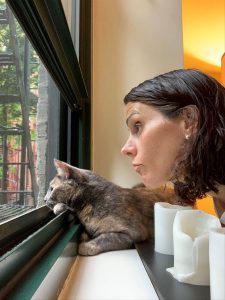
 Charlotte Matthews career spans building design, construction management, real estate development and urban tech, always with the goal of finding scalable solutions to reduce the climate impact of buildings. At Sidewalk Labs, Charlotte leads a cross-functional team that marries real estate and utility experience, with product development and commercialization to address the challenge of electrifying the built environment without massive cost impacts to utility customers.
Charlotte Matthews career spans building design, construction management, real estate development and urban tech, always with the goal of finding scalable solutions to reduce the climate impact of buildings. At Sidewalk Labs, Charlotte leads a cross-functional team that marries real estate and utility experience, with product development and commercialization to address the challenge of electrifying the built environment without massive cost impacts to utility customers.
Can you tell us a little bit about your professional background?
I knew very early that protecting the environment would be the guiding mission of my working life, but it took going door to door for an environmental campaign one summer to find the focus on buildings. If development was inevitable, at least it could be more environmentally attuned than the suburban subdivisions through which I was walking.
I moved from building design into construction, and then into development so I could green the whole process from site planning through operation. The main leverage point I gained was being able to make the economic case for energy improvements and to find the money when it was lacking. My final project in development was a 13.3MW cogeneration plant for a new mixed-use neighborhood. Eventually, I realized that little had changed in building design and operation over the 20 years of my career, and real estate wasn’t leaning into the potential of data collection and technology to improve building performance.
So, I joined Sidewalk Labs, a technology firm committed to urban innovation and technology. My current project, Affordable Electrification, marries power pricing with home automation to give residents a predictable monthly utility bill while allowing utilities to vary the cost of power so it’s very expensive at peak time and virtually free off peak. The core thesis is that we need to change the way we price power if we want to stimulate load shifting to flatten demand peaks. Advances in home and appliance automation can make this possible without causing residents’ economic harm.
What interests you the most about CMC and its vision and values?
I’m excited to join the CMC board because in all of my jobs thus far, I’ve worked toward the promise of energy and carbon savings for residents, while CMC actually delivers those savings. I have so much respect for the hard, tangible work that CMC does and hope I can be helpful to further and expand the benefits of those efforts.
There are two additional things that drew me to CMC:
- Community development is at the heart of its work. I believe equity and economic opportunity must be central to environmental work.
- CMC does the critical resident education and trust building that enables the work of saving energy to take place. All energy policy, incentives, data collection, and technology improvements amount to a hill of beans if no one ever accesses the home or building and performs the energy audit, air sealing and retrofits.
What do you do in your free time?

I spend a lot of time nursing running injuries and finding things to do that aren’t running, like walking, tennis and swimming. And since confinement began in March, I’ve been at the beck and call of a spunky cat who has me playing hide and seek and throwing a ball for more hours than I’d care to admit. I swear I used to be interesting before 2020.
As a sports crazy company, what teams do you support?
I have a signed Tom Brady Pats jersey hanging on my wall. Cam Newton was a very exciting pick, but my eye has been wandering south to follow Tom, since he’s still winning games at 43. Gives hope to all of us over 40.

